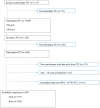C-Reactive Protein and TGF-α Predict Psychological Distress at Two Years of Follow-Up in Healthy Adolescent Boys: The Fit Futures Study
- PMID: 35360574
- PMCID: PMC8963454
- DOI: 10.3389/fpsyg.2022.823420
C-Reactive Protein and TGF-α Predict Psychological Distress at Two Years of Follow-Up in Healthy Adolescent Boys: The Fit Futures Study
Erratum in
-
Corrigendum: C-Reactive Protein and TGF-α Predict Psychological Distress at Two Years of Follow-Up in Healthy Adolescent Boys: The Fit Futures Study.Front Psychol. 2022 Jul 1;13:953498. doi: 10.3389/fpsyg.2022.953498. eCollection 2022. Front Psychol. 2022. PMID: 35846700 Free PMC article.
Abstract
Objective: The scarcity of research on associations between inflammatory markers and symptoms of depression and anxiety during adolescence has yielded inconsistent results. Further, not all studies have controlled for potential confounders. We explored the associations between baseline inflammatory markers and psychological distress including moderators at follow-up in a Norwegian adolescent population sample.
Methods: Data was derived from 373 girls and 294 boys aged 15-18 years at baseline, in the Fit Futures Study, a large-scale 2-year follow-up study on adolescent health. Baseline data was gathered from 2010 to 2011 and follow-up data from 2012 to 2013. Psychological distress was measured with Hopkins Symptom Checklist (HSCL-10). Serum levels of the following inflammatory markers were measured: C-reactive protein (CRP), Interleukin 6 (IL-6), Transforming growth factor alpha (TGF-α), Tumor necrosis factor alpha variant 1 (TRANCE), and variant 2 (TWEAK). Independent associations between baseline inflammatory markers and HSCL-10 at follow-up were explored by linear regressions, in sex-stratified analyses.
Results: In girls, analyses showed positive associations between all inflammatory markers and HSCL-10, except for TRANCE. However, all associations were non-significant in crude as well as in adjusted analyses. In boys, CRP (p = 0.03) and TGF-α (p < 0.01) showed significant associations with HSCL-10, that remained significant after adjustment. Additionally, moderators were found. In boys, CRP was associated with HSCL-10 in those with high body fat and those being physical inactive, and the association between TWEAK and HSCL-10 was dependent upon sleep duration.
Conclusion: There were significant prospective associations between CRP, TFG-α, and HSCL-10 in boys aged 15-18 years at baseline.
Keywords: adolescence; anxiety symptoms; depressive symptoms; inflammatory markers; psychological distress.
Copyright © 2022 Linkas, Ahmed, Csifcsak, Emaus, Furberg, Grimnes, Pettersen, Rognmo and Christoffersen.
Conflict of interest statement
The authors declare that the research was conducted in the absence of any commercial or financial relationships that could be construed as a potential conflict of interest.
Figures
Similar articles
-
Two-year changes in sleep duration are associated with changes in psychological distress in adolescent girls and boys: the fit futures study.Health Psychol Behav Med. 2022 Nov 21;10(1):1159-1175. doi: 10.1080/21642850.2022.2147936. eCollection 2022. Health Psychol Behav Med. 2022. PMID: 36437871 Free PMC article.
-
Are pro-inflammatory markers associated with psychological distress in a cross-sectional study of healthy adolescents 15-17 years of age? The Fit Futures study.BMC Psychol. 2022 Mar 15;10(1):65. doi: 10.1186/s40359-022-00779-8. BMC Psychol. 2022. PMID: 35292108 Free PMC article.
-
Corrigendum: C-Reactive Protein and TGF-α Predict Psychological Distress at Two Years of Follow-Up in Healthy Adolescent Boys: The Fit Futures Study.Front Psychol. 2022 Jul 1;13:953498. doi: 10.3389/fpsyg.2022.953498. eCollection 2022. Front Psychol. 2022. PMID: 35846700 Free PMC article.
-
Peripheral levels of C-reactive protein, tumor necrosis factor-α, interleukin-6, and interleukin-1β across the mood spectrum in bipolar disorder: A meta-analysis of mean differences and variability.Brain Behav Immun. 2021 Oct;97:193-203. doi: 10.1016/j.bbi.2021.07.014. Epub 2021 Jul 28. Brain Behav Immun. 2021. PMID: 34332041
-
The longitudinal associations of inflammatory biomarkers and depression revisited: systematic review, meta-analysis, and meta-regression.Mol Psychiatry. 2021 Jul;26(7):3302-3314. doi: 10.1038/s41380-020-00867-4. Epub 2020 Aug 17. Mol Psychiatry. 2021. PMID: 32807846 Free PMC article.
Cited by
-
Two-year changes in sleep duration are associated with changes in psychological distress in adolescent girls and boys: the fit futures study.Health Psychol Behav Med. 2022 Nov 21;10(1):1159-1175. doi: 10.1080/21642850.2022.2147936. eCollection 2022. Health Psychol Behav Med. 2022. PMID: 36437871 Free PMC article.
References
-
- Bakken A. (2019). “Ungdata 2019: Nasjonale resultater (9/19).” [NORWEGIAN]. NOVA-Norsk institutt for forskning om oppvekst, velferd og aldring. [NORWEGIAN]. Available at: https://oda.oslomet.no/oda-xmlui/bitstream/handle/20.500.12199/2252/Ungd... (Accessed February 21, 2022).
LinkOut - more resources
Full Text Sources
Research Materials
Miscellaneous



